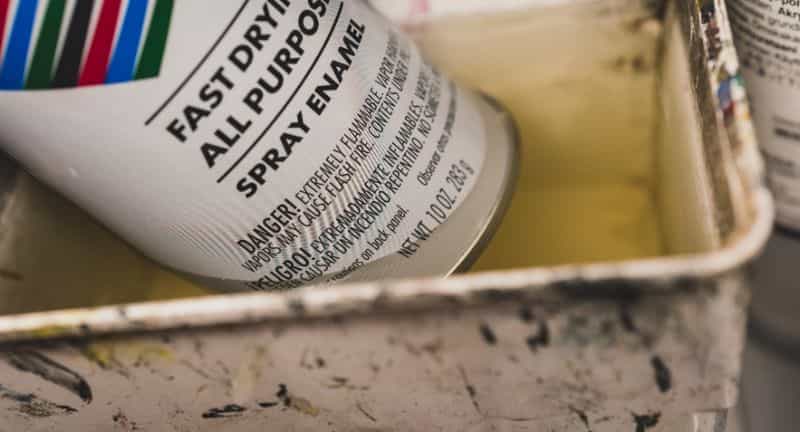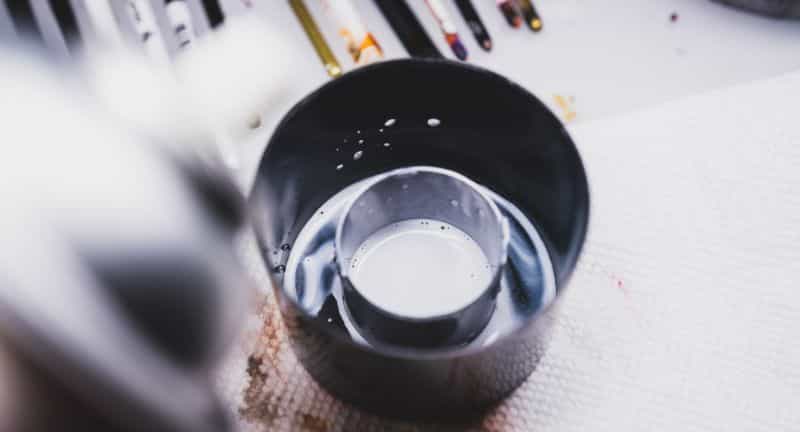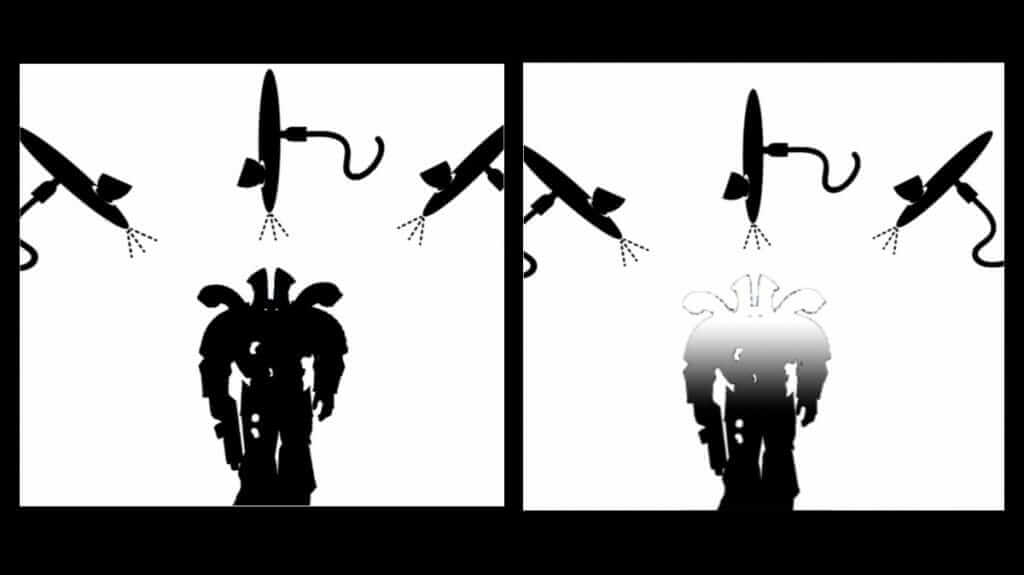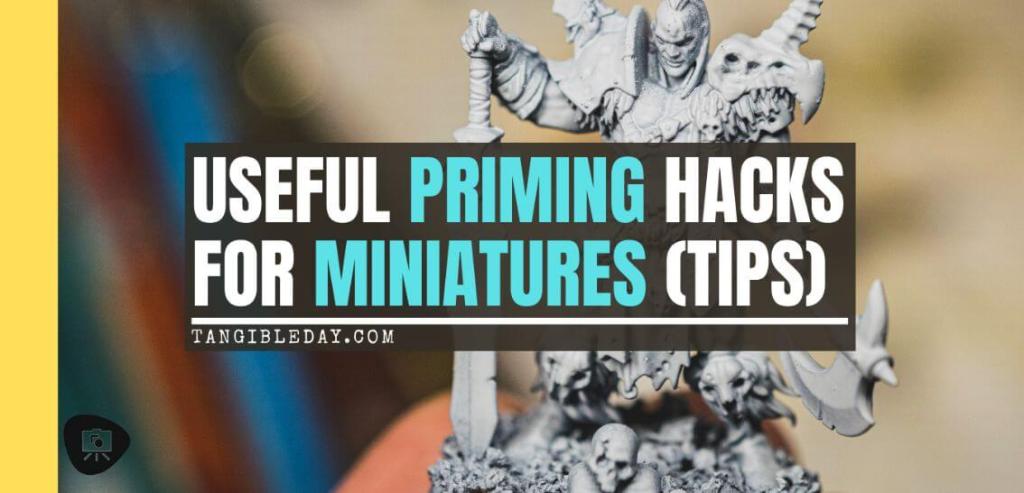Priming miniatures is a key part of the miniature painting process. Every miniature painter needs to prime their models. Model hobby primers work best when you apply them in thin even coats, which helps smooth out surface imperfections in plastic, metal or resin. A good primer application retains model detail, while helping overlying paint stick. Of course, for best results, you’ll want to know a few other tricks and tips for priming your models.
In this article, I share 6 must-know miniature priming hacks that will help you start painting your miniatures with a great foundation. I’ve been painting miniatures for a long time, both as a commission painter and with my own collection of models. These include minis from wargames like Warhammer 40k, and board games like Zombicide. In every case, the painting process always starts with a good model primer.
Primers: A Smooth Operation
Primers work as a preparatory layer that allows paint to stick properly to a model’s surface. The most useful primers for miniature painting have a matte finish. The matte texture of a modeling primer helps acrylic, enamel, or oil paints adhere and blend properly as you paint. This finish also ensures that you can see detail, since a non-reflective surface doesn’t distort light and shadows on a model.
For more details, see this guide about how to apply primers and a review of my recommended primers for painting miniatures. In general, spraying a primer works best for achieving a thin, even coat on a scale model or miniature.
For those with an airbrush, my recommendation is to use a water-soluble primer like Vallejo Surface Primer or Badger’s Stynylrez Primer. They both work great straight from the bottle with no or little thinning with water. The best airbrush for priming miniatures is any airbrush with a 0.3mm nozzle tip or larger. A gravity feed, double-action airbrush is the generalist workhorse airbrush for scale model and miniature painting.

RELATED: RECOMMNEDED AIRBRUSHES FOR PRIMING AND PAINTING MINIATURES
6 Must-Know Hacks, Tips and Tricks for Priming Miniatures
Sometimes you have to get creative with your hobby supplies to overcome limitations, difficulties, or make something entire new work for you. With primers, there are certain issues that arise that call for your innovative thinking and ingenuity.
Here are 6 tips and tricks with primers that I’ve used to help me paint miniatures.
- Partially submerge an aerosol primer in lukewarm water, if working in cold weather
- Collect aerosol primer in a container to apply it with a regular brush
- Mix primer colors for a variety of miniature painting techniques
- Apply automotive primer and filler for 3D prints or DIY terrain
- Try using gesso to prime miniatures
- A matte varnish works as a primer
Continue reading to see how these miniature priming hacks can help you paint your models.
Tip #1 – Partially Submerge an Aerosol Primer in Lukewarm Water, if Working in Cold Weather
If you’re using an aerosol or rattle can primer, the temperature of the can will significantly affect the quality of the priming application. In general, cold ambient temperature is worse for priming than warm or hot weather. When aerosol can is warm, the internal primer mixture works best because the air pressure (which affects relative humidity) is sufficiently high.
Without getting into the granular physics of the relationship of pressure, volume, substance mass, ideal gas constant, and temperature (aka PV=nRT or the “ideal gas law”), when you spray a pressurized can of primer, the expanding air results in a cooling of the entire rattle can. In other words, when you release a pressured gas to spray a primer, you are causing an endothermic process.
This is how it works: The compressed primer particles move farther apart when you spray. For this to happen, heat energy must be absorbed into the can (e.g., the endothermic process). This makes the metal can feel cold while you’re priming. This is actually a good sign that your primer was at a good baseline temperature for applying it to your models.
The problem is when you’re trying to spray an aerosol primer when everything–the can and ambient air–are cold. In cold weather, the primer mixture isn’t very good, and will spray with a sputtering behavior and the primer will look splotchy on your miniature. It is also possible that in cold weather the primer will clump up due to poor atomization as you spray.

I say all of this to emphasize that it is essential that you prime your models in good conditions for best results. Correcting or fixing a bad priming job is difficult. It is often involves stripping a model completely back to bare plastic, metal, or resin.
To avoid issues with any aerosol primer, try and control the environment. Other than warming the metal spray can, you can work indoors with a spray booth that has active venting to prime models. Note: Be careful with some spray booths because of the flammable solvents in aerosol primers.
If you must prime in cooler temperatures, here’s how you can warm the aerosol can. Simply submerge a part of the metal spray can in a bowl or container of lukewarm water, which is around 98 to 105 degrees Fahrenheit, or 36.5 to 40.5 degrees Celsius. After submerging the primer can in warm water for at least 5 minutes, shake the can well, and spray your models or miniatures as you normally would. Do not overheat any aerosol can, which can lead to an explosion.
As the primer can cools down while you spray, you should return the aerosol to the warm water again. Aim to keep the primer can warm until you finish your priming application. This will help achieve a more reliable, consistent priming application, even if you’re working in cold ambient temperatures.
Tip #2 – Collect Aerosol Primer in a Container to Apply it With a Regular Brush
There may come a point when you’ll want to use a brush to apply primer to a model, instead of spraying it. But, what if you only had an aerosol primer with a specific color you wanted?
For example, perhaps you need to cover a small spot with primer on your miniature, but don’t want to overspray other areas of the model. Painter’s tape or sticky tack could help you mask off areas if you wanted to spray some parts of a model, while avoiding other areas. But, masking may be too much work, or isn’t practical.
Instead, you can collect the primer from an aerosol can into a glass jar or other container. To collect the liquid primer from an aerosol can, all you need to do is spray it out into a paper cup or other “tall” container. The taller the walls of the container, the easier it will be to avoid making a mess and wasting the primer.

Move the spray nozzle close to the side, bottom, or wall of the cup or other container (less than an 1-2 inches) and spray until the primer runs down and pools up. The pool of primer you collect is perfectly fine with a paint brush. Dip your paint brush into the pool of aerosol primer and apply it normally to your model.
Remember to use a face respirator or breathing mask to avoid breathing in the fumes, as you’ll get a lot of kicked up mist from the close-quarter spraying.

I’ve used this method to cover up spots I missed spraying models with colored primers. It helps me avoid using the large spray pattern of an aerosol that would mess with parts of a model that I already painted or worked on. This primer collection and brush-on method also works well for other aerosolized media, too, such as spray varnishes or paints (which I would use on large terrain pieces).
Tip #3 – Mix Primer Colors for a Variety of Miniature Painting Techniques
This is a great trick you can use to change up how your model’s look during the priming phase. You can also do this with aerosol or surface primers (applied with an airbrush or regular brush). An obvious way to use mix primer color is to spray a primer using the zenithal highlighting technique. Zenithal highlighting quickly reveals light cast and shadow detail over a miniature sculpt. Using a transparent acrylic glaze, you can rapidly color a model while maintaining high contrast.

Similarly, you can use a regular brush to apply a coat of colored primer. Then, you can brush on another primer to sketch in the highlights (or shadows). Essentially, you’re using the primer as you would a regular paint. However, because this primer coat is only used as a “underpainting”, you have the freedom to explore form, light, and shade before applying you actual paint on top.

Finally, a technique I use with mixing primer colors is to create a tonal base for my overlying paint job. I personally don’t enjoy painting directly on pure black or white surfaces. I much rather start a miniature painting on a colored surface, or at the very least a neutral gray tone.
To create an off-white or off-black primer base to paint over on a model, I mix two surface primers together in a ceramic watercolor palette. I use the end of a brush handle as a poor man’s stirrer to mix the primers. After mixing, I either use an airbrush or regular brush to apply the primer to my miniatures, avoiding some of the common priming mistakes.
Although for most models I paint I use a mixture of black and white primer to make a gray tonal undercoat, I’ll also mix up a white and brown surface primer to create a sepia or warm tonal undercoat. I love working on warm tones with my miniatures, especially organic, humanoid like miniatures where there is flesh or skin. The color contrast that immediately appears when I paint on top of these base primer colors is simply fun to see.
For those of you wondering, yes, you can mix a primer with regular acrylic paint or ink to change the color. For example, you can mix a white surface primer with an acrylic blue or red paint, which may help those painting Warhammer 40k Space Marines. When you do this, just be sure that both the primer and colored paints/inks you’re mixing use the same water-based solvent.
Finally, ensure that most of your primer mixture is “primer”, and not “paint”. When you dilute primer in anything else, it starts to lose its ability to smooth out details, adhere to the model’s surface, and won’t be as effective. Overall, mixing primer colors is a unique and creative way to change-up your early stage approach to painting miniatures.
Tip #4 – Use Automotive Primer and Filler for 3D Prints or DIY Terrain
A main purpose of any primer is to help smooth out surface imperfections in miniatures and scale models. The tiny fissures, microscopic holes, and bumps on a model can disrupt a good paint job. A well applied primer will condition the working surface and help overlying paint stick, and facilitate more advanced color blending techniques.
Of course, in the process of smoothing out undesired textures on a model, a hobby primer shouldn’t cover up fine details on a miniature. Using too much primer, or applying primer too thick is counterproductive. For scale models and miniatures, you’ll want to use an appropriately formulated primer.

On the other hand, for 3D prints that have print layer artifacts, perhaps you do want a primer that fills in textures more aggressively. There are many ways to smooth out 3D prints to prepare them for a nice paint job. One proven way to help you paint 3D prints and DIY terrain–both of which have textures that you may want to evenly smooth out–is to apply a few coats of an automotive primer + filler.

The benefit of an automotive primer and filler is that it is designed to “fill-in” deep scratches, crevices, or bumps in the surface you want to paint. Additionally, after the primer + filler dries, you can sand the surface to smooth it even further. For a truly even, smooth surface, alternate applying primer + filler and sanding. Cycle this application (primer/sanding) several times, if necessary.
For 3D printed models and homemade terrain, using a primer and filler combo will not only help you paint the pieces, but also do the job more effectively. I recommend you use an aerosolized primer + filler first, if you have the space and right ambient conditions for spraying. If not, a regular brush applied primer + filler will do fine, too.
Give it a try!
Tip #5 – Prime Miniatures with Gesso
Gesso is a traditional compound that artists use to prime canvas and other surface in preparation for paint. If you do a search online, you’ll find quite a bit of information about how to use gesso. For miniatures, I’ve discovered that gesso is a useful as an alternative to conventional hobby primer for resin and metal models. This is because gesso uses a plaster or glue-based medium that hardens in a durable surface.
Scratched or chipped primer often plagues those of us who work with metal or resin miniatures. Whether this is due to residual manufacturing lubricants on the model (remember to wash your model before priming and painting), or the metal/resin material itself isn’t as compatible with regular primer, gesso has always endured harsh handling of the minis.
To apply gesso, you will have to use a regular brush. It is too thick to airbrush and will not work well even if thinned with water. Gesso contains coarser particles that give it a rougher texture when dry. This texture or tooth helps paints stick to the coated substrate. If you’re a miniature painter who uses oil paints, you’ll love using gesso for its ability to absorb solvent making the paint cure faster. It also helps with color blending.

Gesso is an inexpensive medium and for the same cost, you can prime a lot of models! The gesso I recommend miniature painters use is Liquitex Gray Gesso. It works great for priming large models and terrain. Because it is resilient to scratches and stretches out when it dries, Liquitex Gray Gesso forms a very smooth and pleasant surface to paint on.
A disadvantage of gesso use as a primer is that it is a thick medium. It will cover details easily, so you have to be careful not to let it pool in one place. It also tends to grip paint a tad too much, due it’s more textured surface. If you’re looking buttery smooth color blends using acrylic painting techniques like wet-blending, you may have some difficulty with a gesso primed model.
Overall, if you’re looking for an inexpensive, durable primer that will give your acrylic or oil paints a great surface to stick to, gesso might be a wonderful alternative to your conventional surface primers. As a final note, having a bottle of gesso around is nice just in case you want to paint something with the traditional 2D medium, e.g., canvas or paper.
Tip #6 – A Matte Varnish Works as a Primer
I learned this priming trick when I was away at a miniature gaming convention. Traveling, I packed everything in my portable paint case, but forgot to bring primer to paint new minis I purchased. I really wanted to get started on them!
For the first day, I pondered whether any of the onsite vendors were selling primer. Unfortunately, I had arrived late and they either didn’t have any primer in stock or were sold out for the day. Suffice it to say, I surrendered to the fact that I would have to paint models that I brought with me that were already primed or partially painted.

Then, out of the blue, a nice young woman mentioned to me she had been priming her models with a matte varnish for years. She never used “real primer”, because it was a hassle to spray primer indoors and she didn’t like the smell. Instead, she opted to use a matte varnish to prepare her models for paint.
Luckily, I had a bottle of Vallejo Matte Sealer, which I use to make DIY washes. I decided to give it a try.

I put some sealer on a plastic palette and used a regular brush to coat my bare metal miniature. The varnish stuck well to the surface, smoothed out a few bumpy bits, and dried into a clear, matte surface. It looked odd, and nothing like a regular primer coat.
When I started base coating the miniature with acrylic hobby paint, e.g., Reaper and Citadel, the paint stuck really well. I was able to paint normally over the matte varnish that I’d repurposed as a model primer. This was a profound discovery!
You can repurpose a matte varnish as a model primer. 🤯
For the rest of the convention, I played around with using the matte varnish sealer as a priming medium. It worked on plastic and metal. I was able to use it to prepare my miniatures for regular acrylic paint jobs. I eventually finished painting those models, and the overlying paint job has held up well after all these years.
Would I continue using matte varnish as a primer, even if I had actual primer available? I don’t think I will, only because I already have stockpiles of primer. I also like how regular primers coat models in an even color and tone. Primers make painting easier because they visually even out the details and appearance of the 3D model’s surfaces.
If you’re like me and curious about whether a varnish could serve as an alternative primer, you may want to try it out yourself. On the 2 or 3 models I primed with a matte varnish, I found it works great. I don’t recommend using a gloss or stain varnish. I think the matte texture helped overlying paint adhere to the model.
Final Thoughts
Painting and other creative arts has always required individuals to innovate. If something isn’t available to do something you want, then you invent or improvise. Through the years, I’ve played around with different ways and tools of doing the same thing. In this case, priming a miniature for paint sounds like a simple process. And, it is!
There are times when you need flexibility. The same formula doesn’t always work. This article highlights a few alternative ways you can apply and use primer on your minis. Although in most cases, these methods are situational, there may be a time when you need them to achieve a certain result.
I hope you found these priming tips and tricks interesting, helpful, or simply a good note to keep for later!
Happy priming (and painting)!



Tangible Day on YouTube (Miniatures and More!)


Super article, thank you. You have a new follower 🙂 Do you have a youtube channel?
Yeah thank you! I do have a YT channel :). https://youtu.be/IXVnyN-fHYc I am slowly adding more quick videos.